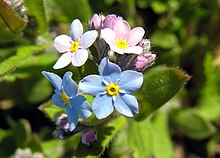Myosotis
| Myosotis | |
|---|---|

| |
| Myosotis arvensis | |
| Scientific classification | |
| Kingdom: | |
| (unranked): | |
| (unranked): | |
| (unranked): | |
| Order: | (unplaced)
|
| Family: | |
| Genus: | Myosotis |
| Type species | |
| Myosotis scorpioides L. [1]
| |
Myosotis (/ˌmaɪ.əˈsoʊtɪs/;[2] from the Greek: "mouse's ear", after the leaf) is a genus of flowering plants in the family Boraginaceae. In the northern hemisphere they are commonly called forget-me-nots[3] or scorpion grasses.
Distribution
There are currently 74 accepted species in the genus although some 503 species names have been recorded, many of which are synonyms of currently accepted names and others are awaiting resolution.[4] The genus is largely restricted to two discrete geographic centres - western Eurasia with about 60 confirmed species and New Zealand with around 40 confirmed species. Very small numbers of species occur elsewhere including North America, South America and Papua New Guinea.[3] Mysosotis species are now common throughout temperate latitudes through the planting of cultivars and introductions of alien species.
Morphology
Myosotis have 5-merous actinomorphic flowers with 5 sepals and petals. Flowers are typically 1 cm diameter (or less), flat, and blue, pink, white or yellow with yellow centers, growing on scorpioid cymes. They may be annual or perennial with alternate leaves. They typically flower in spring or soon after snow-melt in alpine eco-systems.

Their seeds are found in small, tulip-shaped pods along the stem to the flower. The pods attach to clothing when brushed against and eventually fall off, leaving the small seed within the pod to germinate elsewhere.
Myosotis scorpioides is also known as scorpion grass due to the spiraling curve of its inflorescence. Myosotis alpestris is the state flower of Alaska.
Ecology
Mysosotis' are used as food plants by the larvae of some Lepidoptera species including the setaceous Hebrew character.
Related genera
The Chatham Islands forget-me-not belongs to a related genus, Myosotidium.
Species
Currently 74 species are classified as accepted species at The Plant List:[4] of which 40 are endemic to New Zealand.[5] The full list of species includes the following:
- Myosotis abyssinica Boiss. & Reut.
- Myosotis afropalustris C.H. Wright
- Myosotis albiflora Banks & Sol. ex Hook. f.
- Myosotis alpestris F.W.Schmidt -- Alpine forget-me-not
- Myosotis alpina Lapeyr
- Myosotis ambigens (Bég.) Grau
- Myosotis antarctica Hook. f.
- Myosotis arvensis (L.) Hill - field forget-me-not
- Myosotis asiatica (Vestergr. ex Hultén) Schischk. & Serg. -Asiatic forget-me-not
- Myosotis azoricaH.C. Watson - Azores forget-me-not
- Myosotis balbisiana Jord.
- Myosotis baltica Sam. ex Lindm.
- Myosotis bothriospermoides Kitag
- Myosotis cadmea Kitag
- Myosotis caespitosa Schultz- tufted forget-me-not
- Myosotis decumbensHost
- Myosotis discolor Pers -changing forget-me-not
- Myosotis densiflora C. Koch
- Myosotis incrassata Guss.
- Myosotis krylovii Serg.
- Myosotis lamottiana (Braun-Blanq. ex Chass.) Grau
- Myosotis latifolia Poir. - broadleaf forget-me-not
- Myosotis laxa Lehm.- tufted forget-me-not, Bay forget-me-not
- Myosotis lithospermifolia Hornem.
- Myosotis nemorosa Besser
- Myosotis petiolata var. pansa (L.B.Moore) Meudt, Prebble, R.J.Stanley & Thorsen subsp. pansa - Waitakere forget-me-not
- Myosotis ramosissima Rochel - early forget-me-not
- Myosotis rivularis (Vestergr.) A.P. Khokhr
- Myosotis sachalinensis Popov
- Myosotis scorpioides L. - true forget-me-not
- Myosotis secunda - creeping forget-me-not
- Myosotis sicula Guss. - Jersey forget-me-not
- Myosotis sparsiflora J.C.Mikan ex Pohl
- Myosotis speluncicola Schott ex Boiss
- Myosotis stenophylla Knaf
- Myosotis stricta Link ex Roem. & Schult
- Myosotis strigulosa Rchb.
- Myosotis sylvatica Ehrh. ex Hoffm - wood forget-me-not
- Myosotis verna Nutt. - spring forget-me-not
Gallery
- Myosotis in art
-
Plate XXXVII of Hooker's Flora Antarctica. Myosotis capitata Hook. fil.
-
Wohlfahrtsmarke, de, 1977
-
Alexandre Dang, Field of Dancing Solar-Powered Forget-me-nots, art installation in the Royal Greenhouses of Laeken.
References
- ^ Carlos Lehnebach (2012). "Lectotypification of three species of forget-me-nots (Myosotis: Boraginaceae) from Australasia". Tuhinga. 23: 17–28.
- ^ "Myosotis". Oxford English Dictionary (Online ed.). Oxford University Press. (Subscription or participating institution membership required.)
- ^ a b Richard C. Winkworth, Jürke Grau, Alastair W. Robertson & Peter J. Lockhart (2002). "The origins and evolution of the genus Myosotis" (PDF). Molecular Phylogenetics and Evolution. 24 (2): 180–193. doi:10.1016/S1055-7903(02)00210-5. PMID 12144755.
{{cite journal}}: CS1 maint: multiple names: authors list (link) - ^ a b "Species in Myosotis". The Plant List. Retrieved March 28, 2015. Plant Life - Myosotis]
- ^ NZ Flora factsheet - Myosotis


